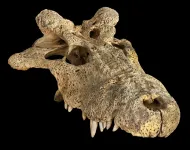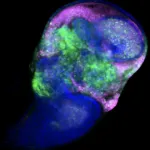(Press-News.org) A study led by scientists at the American Museum of Natural History has resolved a long-standing controversy about an extinct "horned" crocodile that likely lived among humans in Madagascar. Based on ancient DNA, the research shows that the horned crocodile was closely related to "true" crocodiles, including the famous Nile crocodile, but on a separate branch of the crocodile family tree. The study, published today in the journal Communications Biology, contradicts the most recent scientific thinking about the horned crocodile's evolutionary relationships and also suggests that the ancestor of modern crocodiles likely originated in Africa.
"This crocodile was hiding out on the island of Madagascar during the time when people were building the pyramids and was probably still there when pirates were getting stranded on the island," said lead author Evon Hekkala, an assistant professor at Fordham University and a research associate at the American Museum of Natural History. "They blinked out just before we had the modern genomic tools available to make sense of the relationships of living things. And yet, they were the key to understanding the story of all the crocodiles alive today."
The arrival of modern humans in Madagascar between about 9,000 and 2,500 years ago preceded the extinction of many of the island's large animals, including giant tortoises, elephant birds, dwarf hippos, and several lemur species. One lesser-known extinction that occurred during this period was that of an endemic "horned" crocodile, Voay robustus. Early explorers to Madagascar noted that Malagasy peoples consistently referred to two types of crocodiles on the island: a large robust crocodile and a more gracile form with a preference for rivers. This suggests that both types persisted until very recently, but only the gracile form, now recognized as an isolated population of the Nile crocodile (Crocodylus niloticus), is currently is found on the island.
Despite nearly 150 years of investigation, the position of the horned crocodile in the tree of life has remained controversial. In the 1870s, it was first described as a new species within the "true crocodile" group, which includes the Nile, Asian, and American crocodiles. Then, in the early part of the 20th century, it was thought that the specimens simply represented very old Nile crocodiles. And finally, in 2007, a study based on physical characteristics of the fossil specimens concluded that the horned crocodile was actually not a true crocodile, but in the group that includes dwarf crocodiles.
"Teasing apart the relationships of modern crocodiles is really difficult because of the physical similarities," Hekkala said. "Many people don't even realize that there are multiple species of crocodiles, and they see them as this animal that's unchanging through time. But we've been trying to get to the bottom of the great diversity that exists among them."
To fully examine the horned crocodile's place in the evolutionary tree, Hekkala and her collaborators at the Museum made a number of attempts to sequence DNA from fossil specimens, including two well-preserved skulls that have been at the Museum since the 1930s.
"This a project we've tried to do on and off for many years, but the technology just hadn't advanced enough, so it always failed," said study co-author George Amato, emeritus director of the Museum's Institute for Comparative Genomics. "But in time, we had both the computational setup and the paleogenomic protocols that could actually fish out this DNA from the fossil and finally find a home for this species."
The results place the horned crocodile right next to the true crocodile branch of the evolutionary tree, making it the closest species to the common ancestor of the crocodiles alive today.
"This finding was surprising and also very informative to how we think about the origin of the true crocodiles found around the tropics today," Amato said. "The placement of this individual suggests that true crocodiles originated in Africa and from there, some went to Asia and some went to the Caribbean and the New World. We really needed the DNA to get the correct answer to this question."
INFORMATION:
Other authors on the study include John Gatesy, Apurva Narechania, Shaena Montanari, and Mark Norell from the American Museum of Natural History; Robert Meredith and Matthew Aardema from the Museum and Montclair State University; Michael Russello from the University of British Columbia; Evelyn Jenson from the University of British Columbia and Newcastle University; and Christopher Brochu from the University of Iowa.
Funding was provided in part by the University of California, Riverside, Fordham University Faculty Fellowship, and the National Science Foundation grant no.s RAPID DEB-1931213, DEB-1556701, and DBI-1725932.
Paper DOI: 10.1038/s42003-021-02017-0
ABOUT THE AMERICAN MUSEUM OF NATURAL HISTORY (AMNH)
The American Museum of Natural History, founded in 1869 and currently celebrating its 150th anniversary, is one of the world's preeminent scientific, educational, and cultural institutions. The Museum encompasses more than 40 permanent exhibition halls, including those in the Rose Center for Earth and Space, as well as galleries for temporary exhibitions. The Museum's approximately 175 scientists draw on a world-class research collection of more than 34 million artifacts and specimens, some of which are billions of years old, and on one of the largest natural history libraries in the world. Through its Richard Gilder Graduate School, the Museum grants the Ph.D. degree in Comparative Biology and the Master of Arts in Teaching (MAT) degree, the only such free-standing, degree-granting programs at any museum in the United States. The Museum's website, digital videos, and apps for mobile devices bring its collections, exhibitions, and educational programs to millions around the world. Visit END
A research group at the RIKEN Center for Biosystems Dynamics Research (BDR) has discovered molecular events that determine whether cancer cells live or die. With this knowledge, they found that reduced consumption of a specific protein building block prevents the growth of cells that become cancerous. These findings were published in the scientific journal eLife and open up the possibility of dietary therapy for cancer.
A tumor is a group of cancer cells that multiplies--or proliferates--uncontrollably. Tumors originate from single cells that become cancerous when genes that cause cells to proliferate are over-activated. However, because these genes, called oncogenes, often also cause cell death, activation of a single oncogene within a cell is not enough for it to become a cancer cell. ...
The COVID pandemic appears to have triggered about a 44% increase in insomnia disorder among health care workers at a medical-school affiliated health system, with the highest rates surprisingly among those who spent less time in direct patient care, investigators say.
Another surprise was that about 10% of the group of 678 faculty physicians, nurses, advanced practice providers, like nurse practitioners and physician assistants, as well as residents and fellows, reported in a 17-question survey that their insomnia actually got better in the early months of the pandemic, says Dr. Vaughn McCall, chair of the Department of Psychiatry and Health Behavior at the Medical ...
The now-familiar sight of traditional propeller wind turbines could be replaced in the future with wind farms containing more compact and efficient vertical turbines. New research from Oxford Brookes University has found that the vertical turbine design is far more efficient than traditional turbines in large scale wind farms, and when set in pairs the vertical turbines increase each other's performance by up to 15%.
A research team from the School of Engineering, Computing and Mathematics (ECM) at Oxford Brookes led by Professor Iakovos Tzanakis conducted an in-depth study using more than 11,500 hours of computer simulation to ...
(Media note: Interviews with Texas Biomed researchers are available with advanced notice. Photos and video of rhesus macaques and the Biosafety Level 3 & 4 laboratories at Texas Biomed are available upon request.)
SAN ANTONIO (April 27, 2021) - When the world was coming to grips with an emerging global pandemic a year ago, scientists at Texas Biomedical Research Institute sprang into action. The rhesus macaques at the Southwest National Primate Research Center (SNPRC) at Texas Biomed were quickly validated as models for studying vaccines designed to protect humans ...
New prostate cancer urine test shows how aggressive disease is and could reduce invasive biopsies
Researchers from the University of East Anglia have developed a new urine test for prostate cancer which also shows how aggressive the disease is.
A new study published today shows how an experimental new test called 'ExoGrail' has the potential to revolutionise how patients with suspected prostate cancer are risk-assessed prior to an invasive biopsy.
The research team say their new test could reduce the number of unnecessary prostate cancer biopsies by 35 per ...
New estimates confirm that miscarriages occur in 15% of all pregnancies, with one in 10 women experiencing a miscarriage in their lifetime. Recurrent miscarriage is less common, affecting about 1% of women in their lifetime.
Existing care for sporadic or recurrent miscarriage is inconsistent and poorly organised worldwide, and a new system is needed to ensure miscarriages are better recognised and women are given the physical and mental health care they need.
Authors recommend at least a minimum service to all women who have had a miscarriage - with increasing care for recurrent miscarriages - to be offered globally, including testing, treatment, pre-pregnancy counselling, and psychological support.
With variations in the definition, ...
Nearly 80 percent of higher education faculty report dealing with student mental health issues--issues that more than 90 percent of faculty believe have worsened or significantly worsened during the pandemic, according to a new nationwide survey led by a Boston University mental health researcher.
"The vast majority of faculty members, myself included, are not trained mental health professionals, but we have a role to play in supporting student well-being," says survey principal investigator Sarah Ketchen Lipson, a BU School of Public Health assistant professor of health law, policy, and management. "These data underscore a real opportunity to better equip faculty with knowledge and basic skills to ...
As researchers continue to study the neurological impacts of COVID-19, a Houston Methodist international collaboration has documented an unexpectedly frequent occurrence of acute transverse myelitis (ATM) - inflammation of the spinal cord - in 43 COVID-19 patients. Led by Houston Methodist neurologist Dr. Gustavo Roman, the study of existing scientific literature found that patients from 21 countries developed spinal cord lesions after contracting the virus. Symptoms included paralysis and sphincter/bowel dysfunction. The patients ages ranged from 21 to 73 and included about half-and-half women and men. ATM, a rare neurological condition, affects between 1.34 and 4.6 cases per million per year, and researchers believe the unusually high rate in post-COVID-19 patients ...
Each year over 150,000 infants worldwide are infected with HIV in the womb, at birth, or through breastfeeding. Why transmission occurs in some cases but not others has long been a mystery, but now a team led by Weill Cornell Medicine and Duke University scientists has uncovered an important clue, with implications for how to eliminate infant HIV infections.
In a study published April 2 in PLoS Pathogens, the researchers found evidence linking mother-to-child transmission of HIV to rare variants of the virus in the mother's blood that are able to escape broadly neutralizing antibodies (bnAbs)--an emerging ...
3D printing has opened up a completely new range of possibilities. One example is the production of novel turbine buckets. However, the 3D printing process often induces internal stress in the components which can in the worst case lead to cracks. Now a research team has succeeded in using neutrons from the Technical University of Munich (TUM) research neutron source for non-destructive detection of this internal stress - a key achievement for the improvement of the production processes.
Gas turbine buckets have to withstand extreme conditions: under high pressure and at high temperatures they are exposed to tremendous centrifugal forces . In order to further maximize ...





